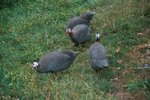Most birds, from parrots to canaries, view a sprig of millet like throwing a stick of cotton candy into a plate of cauliflower. Thankfully, this seed is a bit healthier than that, but it should still be viewed as a treat on top of a diet including pelleted feed, fresh veggies and fruit and other seed mixes.
Popular Grain
Millet is a grain with many varieties consumed widely across Africa, the Indian subcontinent and East Asia. It's catching on in the United States as a gluten-free health food with protective benefits against heart disease and other ailments, but sprays of finger millet and seed mixes containing white millet have been mostly sold in this country for animals.
The carbs and protein packed into these seeds make it like giving a piece of whole-grain bread to a bird. Pet stores and even some grocery stores' pet aisles consistently stock bags of millet sprays, from six-spray packages for a small flock to jumbo boxes or bulk bins for birds that plow through the treat quickly. To keep it at peak freshness, store millet in a dry, cool location in an airtight bag or container.
Sprays for Birds
Millet doesn't just come in the au natural form, which is usually a footlong spray with the tiny seeds densely packed into tantalizing clusters along the stalk. Some manufacturers coat millet with fruity or candy-style flavorings, though bear in mind this just adds calories to what's already considered a treat. Others will break off the buds of seeds and sell the millet in marble-size balls, a good option for little birds such as finches and budgies. You can save money, though, by buying the natural stalks, clipping them into 1-inch pieces and storing these in a zippered plastic bag for snack time.
And sprays aren't the only option. Try buying pearl millet from a health-food store, boiling or baking into a toasty mash that will be relished.
Messy Eaters
Birds will pick at plump strands of millet, making a fine-grained mess of hulls in the vicinity. Clips can easily add a sprig of millet to the side of a cage, but you will have residue floating outside of the cage. Some millet spray holders suspend from the ceiling, helping to cut down on waste. Put near a perch so your bird has a comfortable seat for eating.
You can lay millet across the floor of a cage for ease of munching and contained mess, but this also leaves the spray open to getting soiled by droppings from above. If you have a group of birds out of their cages for playtime, put a millet spray on a paper plate or a baking dish to let everyone come together for a treat. Cut into pieces if your flock is prone to fight over a treat.
When to Feed
If you have a bowl of nutritious pellets or a plump spray of millet in the cage, you'll often find that the daily diet will get ignored for the millet. Make sure that your bird is eating its regular food before supplementing with a millet treat.
The caloric content makes this a good choice for birds who have been stressed, such as soaked millet for weaning birds and ones who have undergone trips to the vet or a molt. If you have a bird sitting on eggs, even infertile ones, and you're worried about whether she's getting the calories she needs, lay a spray of millet within reach of her beak.
Be warned that tiny grains or hulls of millet can find their way up a bird's nose. Check if you notice any respiratory symptoms from a millet-eating bird such as a change in tune, sneezing or nasal discharge.
References
Photo Credits
-
Multiart/iStock/Getty Images





